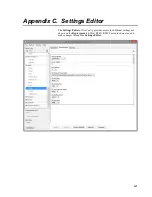
RF451 Spread Spectrum Radio
22
TABLE 9-2. TX/RX LED
LED State
Meaning
Red (solid)
Not used
Green (solid)
Not used
Orange (solid)
Not used
Red (blink)
Transmit
Green (blink)
Receive
Orange (blink)
No Master Detected
(applies only to Slaves and Repeaters)
OFF
No activity / No power
9.2 Troubleshooting Scenarios
DevConfig
is unable to establish a connection with the RF451:
1.
Check that all other Campbell Scientific software is closed.
2.
Check power to the radio. The Status LED should be flashing green if
12 volt power is supplied or red if only USB power is applied.
3.
Check USB cable connections.
4.
Check serial port assignment for
DevConfig
.
Radios not networked together, not communicating:
1.
Check the baud rate of all RF451s/RF450s; they should be the same.
2.
Check Network IDs of all RF451s/RF450s; they should be the same.
3.
Check Frequency Key Number of all RF451s/RF450s; they should be
the same, unless two branches of the network are operating in a
parallel manner. See Appendix
with Parallel Repeaters (using the SubNet ID)
(p. B-5)
, for settings used
in a parallel network.
4.
If one or more radios are configured as repeaters, check the
Repeaters
Used
box for all RF451s/RF450s.
5.
Check the PakBus® address of dataloggers connected to
RF451s/RF450s and in
LoggerNet
.
a.
Check that antenna and antenna cables are correct for each radio
type. RF451 radios use RPSMA (Reverse Polarity SubMiniature
version A). RF450 radio us SMA (SubMiniature Version A).
SMA antennas will have a yellow heat shrink label to distinguish
them from RPSMA.
Summary of Contents for RF451
Page 2: ......
Page 6: ......
Page 10: ...Table of Contents iv ...
Page 34: ...RF451 Spread Spectrum Radio 24 ...
Page 36: ......
Page 46: ...Appendix B Installation Scenarios B 10 ...
Page 58: ...Appendix D Distance vs Antenna Gain Terrain and Other Factors D 10 ...
Page 60: ......
Page 61: ......
















































